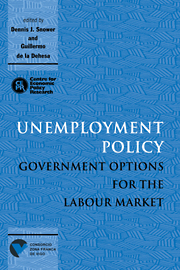Book contents
- Frontmatter
- Contents
- List of figures
- List of tables
- Preface
- Acknowledgements
- List of conference participants
- 1 Introduction
- PART ONE GENERAL POLICY ISSUES
- 2 Evaluating unemployment policies: what do the underlying theories tell us?
- 3 High unemployment from a political economy perspective
- Discussion
- Discussion
- PART TWO DEMAND MANAGEMENT AND SUPPLY-SIDE POLICY
- PART THREE SUBSIDISING EMPLOYMENT AND TRAINING
- PART FOUR LABOUR MARKET REGULATIONS
- PART FIVE POLICY, JOB REALLOCATION AND THE UNEMPLOYMENT–PRODUCTIVITY RELATION
- PART SIX COMPARING UNEMPLOYMENT POLICIES
- Index
2 - Evaluating unemployment policies: what do the underlying theories tell us?
Published online by Cambridge University Press: 07 September 2010
- Frontmatter
- Contents
- List of figures
- List of tables
- Preface
- Acknowledgements
- List of conference participants
- 1 Introduction
- PART ONE GENERAL POLICY ISSUES
- 2 Evaluating unemployment policies: what do the underlying theories tell us?
- 3 High unemployment from a political economy perspective
- Discussion
- Discussion
- PART TWO DEMAND MANAGEMENT AND SUPPLY-SIDE POLICY
- PART THREE SUBSIDISING EMPLOYMENT AND TRAINING
- PART FOUR LABOUR MARKET REGULATIONS
- PART FIVE POLICY, JOB REALLOCATION AND THE UNEMPLOYMENT–PRODUCTIVITY RELATION
- PART SIX COMPARING UNEMPLOYMENT POLICIES
- Index
Summary
Introduction
This chapter is motivated by a simple idea that has received lamentably little attention in the literature on unemployment policy: different unemployment policies are generally based on different theories of unemployment, and our confidence in a policy should depend – at least in part – on the ability of the underlying theory to account for some prominent empirical regularities in unemployment behaviour.
Some theories depict unemployment as the efficient outcome of market activity. These usually serve to rationalise a laissez-faire policy stance. Others depict unemployment as the product of market failures. Here, unemployment must be seen as the symptom of many possible diseases: many different market failures can produce the same problem of joblessness. And just as different diseases require different treatments, so different market failures may call for different government policies. It is because different theories of unemployment focus on different market failures that different policies are generally based on different theories.
It is difficult to evaluate the various unemployment policies by assessing the practical significance of the market failures identified by the underlying theories. After all, market failures arise when people are not fully compensated for the costs and benefits they impose on one another, and uncompensated costs and benefits are inherently difficult to measure. For this reason, it is natural to evaluate unemployment policies by investigating the predictive power of the underlying theories.
- Type
- Chapter
- Information
- Unemployment PolicyGovernment Options for the Labour Market, pp. 15 - 53Publisher: Cambridge University PressPrint publication year: 1997
- 9
- Cited by



